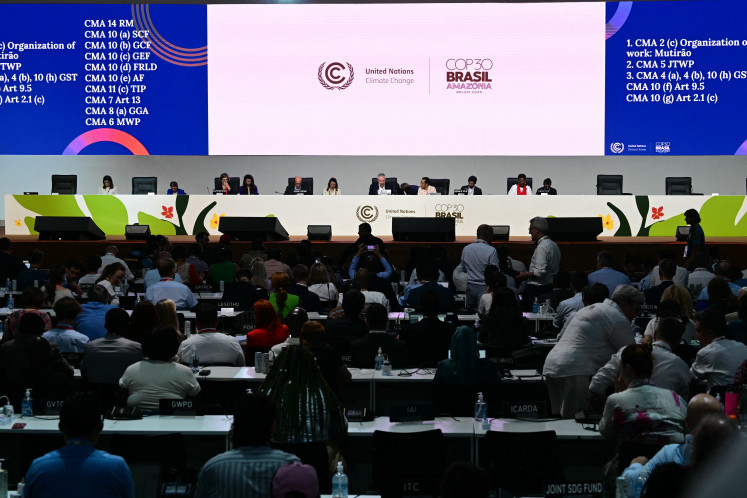Popular Reads
Top Results
Can't find what you're looking for?
View all search resultsPopular Reads
Top Results
Can't find what you're looking for?
View all search resultsFocus on pregnant women to fight malnutrition
Helping parents in lower-income countries to feed their children better is costly, but also improves the children’s nutrition. The investment can deliver benefits worth 16 times the costs.
Change text size
Gift Premium Articles
to Anyone
O
f all our global promises for development that we are on track to fail by 2030—and there are many—one of the most tragic and infuriating is our limited progress on ending global malnutrition. Yet, achieving a drastic reduction in hunger is certainly within our grasp.
We measure chronic malnutrition in so-called stunting, meaning that children are so chronically underfed that they are much shorter than their peers of the same age.
The rich world has reduced stunting to very low levels, and China has achieved a drop to rich-country levels over the past 30 years. Global stunting has almost halved since 1990, but globally more than one in five children are still stunted. The World Bank estimates that in Indonesia, 31 percent of children under the age of five were stunted in 2018.
Stunting decreases children’s survival chances, with 2.7 million children globally dying each year from malnutrition. Stunted children also develop more poorly, and become less productive with a lower income over their entire lifespan. In total, economists estimate the annual global cost of malnutrition to be US$1 trillion.
This year, we’re at halftime of the world’s Sustainable Development Goals that include promises on nutrition and everything else to be achieved by 2030. Yet, we are far from halfway. Based on trends before COVID-19, we will only achieve the goal of zero hunger in the year 2116, 86 years late.
This global failure is what has motivated my think tank, the Copenhagen Consensus Center, to work with some of the world’s best economists to identify which promises should be prioritized to have the greatest impact.
Their new, peer-reviewed research shows that one of the smartest approaches to addressing malnutrition is to focus on pregnant women. For a small cost, they can be provided with micronutrients that will feed their growing fetus better and avoid some malnutrition later.
Most governments already follow WHO recommendations and provide pregnant women with iron and folic acid supplementation to prevent anemia in the mother and neural tube defects in the newborn. This means switching to a pill that includes more micronutrients will only require some minor education and training in the healthcare sector, and it will add only a small cost to the new pills that governments hand out.
These new pills are already being mass-produced and contain 13 vitamins and minerals beyond iron and folic acid, including vitamins A, B1, B2, B6, B12, D, and E plus zinc, copper, iodine, and selenium. They cost so little that for 180 days, the additional cost for each mother is just over a dollar. Helping 36 million women in low- and lower-middle-income countries in a year with these pills along with healthcare training and education will cost just US$84 million in total.
Multi-micronutrient supplements will avoid about 7 percent of almost 700,000 still-births, 21 percent of all low-birth weights, and 5 percent of all preterm births each year. Avoiding low birthweight and preterm birth means children will be less likely to become malnourished. It means 1.6 million children will avoid becoming stunted each year, allowing them to be more productive as adults.
In economic terms, they will become so much better off than the benefits adding up to $3 billion in today’s money. Thus, each dollar spent will deliver an astounding benefit worth 38 times the cost.
Calcium tablets are delivered separately from other micronutrients since the tablets are quite large and two to three are needed every day for the last 20 weeks of pregnancy. The cost is $6 per pregnancy or $216 million for the 36 million pregnant women that currently take iron and folic acid. This will reduce the number of stillbirths by almost twice as much as multi-micronutrients, and it avoids an additional 1.1 million early births and births of low birthweight.
Further, calcium also reduces pre-eclampsia and eclampsia, the rare but serious condition where high blood pressure results in seizures during pregnancy or during birth. This means that calcium may prevent up to 8,500 maternal deaths each year. In total, the benefits of almost $4 billion are 19 times larger than the costs.
Micronutrient supplementation for pregnant women is a fantastic policy, but not a silver bullet. The economists identify several other, very efficient policies. Helping parents in lower-income countries to feed their children better is costly, but also improves the children’s nutrition. The investment can deliver benefits worth 16 times the costs.
We should also invest much more in research to improve agricultural yields. This will generate more food at a lower cost, reducing malnutrition and increasing growth. Each dollar will deliver a remarkable $33 of social benefits.
Investing more in pregnant mothers’ nutritional support turns out to be one of the most efficient ways to make progress on sustainable development. We owe it to the world to invest in such smart policies first.
***
The writer is president of the Copenhagen Consensus and visiting fellow at Stanford University's Hoover Institution.











